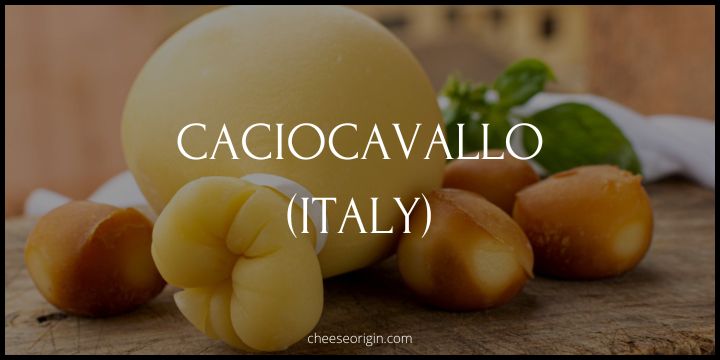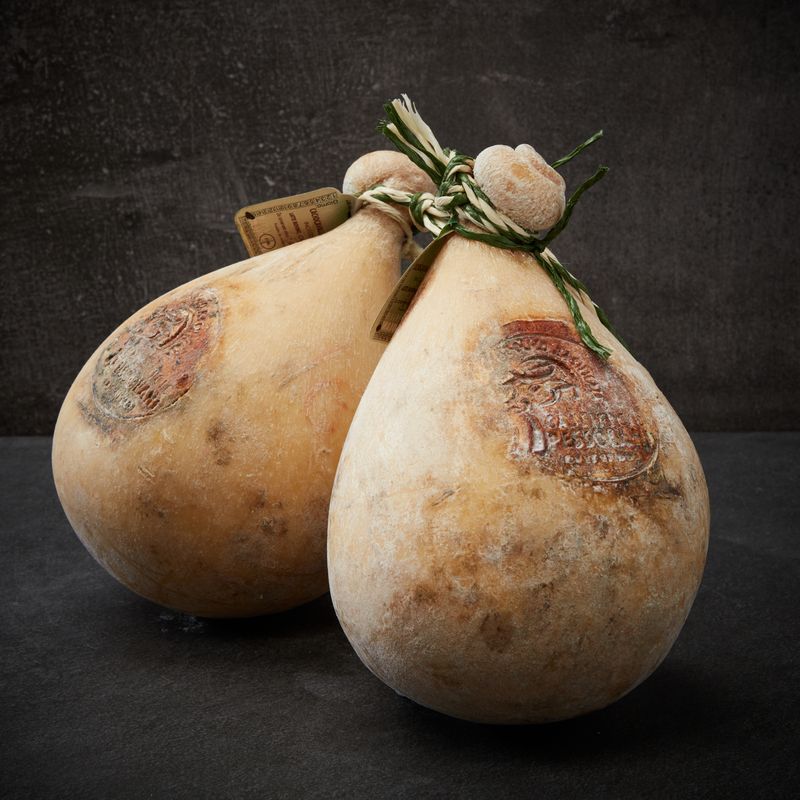What is Caciocavallo? Italy’s Stretched Curd Secret

A staple in Italian cuisine, Caciocavallo is as storied as it is delicious, boasting a rich heritage and a unique flavor profile that sets it apart from its contemporaries. Its name, translating to “horse cheese,” is not an indication of its ingredients, but instead a nod to its traditional aging process.
So, saddle up, and let’s explore the fascinating world of Caciocavallo, the teardrop-shaped cheese that’s been hanging around Italian kitchens since time immemorial.
Quick Facts About Caciocavallo
| Country of Origin | Italy |
| Region | Basilicata, Southern Italy (but basically all over Italy) |
| Classification | Semi-soft, hard (depending on age) |
| Age | From a few days until one year |
| Milk | Cow, buffalo, goat, or sheep |
| Weight | 1 to 10 kg (2.25 – 22 lb) |
| Shape | Sphere |
| Diameter | 11 to 20 cm (4.5 to 8 inches) |
| Height | 23 cm (9 inches) |
| Rind | Natural |
| Aroma | Strong, intense, earthy |
| Taste | Sweet, milky, buttery (first 30 days), Pungent with oily and gamey flavors (after 90 days) |
| Pairing | Rustic bread, quince preserves, fig sauce, onion jam, vegetable soups |
| Beverage pairing | Chianti, Cider, Lagers, Pinot Grigio, or any sparking white wine |
| Texture | Springy, stringy |
| Color | Yellow |
What is Caciocavallo?

Caciocavallo, a cheese that hails from Southern Italy, is a culinary marvel with a unique heritage. Despite its translation to “horse cheese” or “cheese on horseback,” it has little connection with horses. The name instead derives from the traditional method of tying the cheese forms together and hanging them to mature, akin to saddlebags draped over a horse’s back.
This stretched curd cheese is renowned for its high consistency, slightly salty, semi-strong flavor, and hint of spiciness. Its stringy and elastic texture makes it a versatile ingredient in various dishes. From red meat and mushroom-based dishes to stuffed pasta, parmasean-style dishes, pasta casseroles, and homemade pizzas, Caciocavallo adds a unique dimension of taste.
Made from cow’s milk, salt, and lamb or kid rennet, Caciocavallo is a testament to the rich cheesemaking tradition of Italy. Some variants, like Caciocavallo Silano, are also made from ewe’s milk or buffalo milk. Whether you’re a fan of Italian cuisine or a cheese enthusiast, Caciocavallo is a must-try delicacy that offers an unforgettable gastronomic journey.
The 2 Main Types of Caciocavallo
| Characteristics | Caciocavallo Silano | Caciocavallo Podolico |
|---|---|---|
| Origin | Calabria, Basilicata, Apulia, Molise, Campania in Italy | Mostly found in the regions of Puglia, Basilicata, Campania, and Molise |
| Milk Type | Primarily cow’s milk | Primarily Podolica cow’s milk |
| Appearance | Smooth, thin, and shiny rind. Pale yellow to straw color | Thin and hard rind, straw-yellow to brownish in color |
| Texture | Firm, slightly springy | More grainy and crumbly |
| Flavor | Mild, slightly salty with a hint of spiciness | Intense, complex, slightly spicy. Notably earthy and nutty with hints of wild herbs |
| Aging Time | Minimum 15 days | Typically aged longer, from a few months up to a year |
Caciocavallo Tasting Notes
Caciocavallo Silano:
- Initial Flavor: Caciocavallo Silano offers a mild and slightly salty flavor when it is young.
- Complexity: As the cheese matures, the flavor profile deepens, developing a hint of spiciness.
- Texture: The texture contributes to the taste, being firm and slightly springy.
- Pairings: This cheese pairs well with full-bodied red wines, enhancing its taste.
- Culinary Uses: When melted in traditional Italian dishes, Caciocavallo Silano brings a unique, creamy flavor.
Caciocavallo Podolico:
- Unique Flavor: Caciocavallo Podolico is known for its intense, complex flavor that is slightly spicy.
- Earthy Notes: This cheese has a distinctly earthy and nutty taste, with hints of wild herbs.
- Texture: The texture is more grainy and crumbly compared to Caciocavallo Silano, adding to its robust taste.
- Pairings: It pairs beautifully with honey and jam, which can balance out its strong flavors.
- Aging Impact: The cheese is typically aged longer, from a few months up to a year, which enhances its rich and complex flavors.
What Pairs Well With Caciocavallo?
Food Pairings:
- Bread: Caciocavallo can be sliced and served with crusty bread for a simple and satisfying snack.
- Fruits: It pairs well with fruits like pears and figs, which complement its robust flavor.
- Pasta: Grated Caciocavallo can be used as a topping for pasta dishes.
- Grilled: When aged, it can be grilled and served with a drizzle of olive oil.
Drink Pairings:
- Wine: Caciocavallo pairs well with robust red wines such as Aglianico or Primitivo. If you prefer white wine, a Fiano di Avellino can also be a good match.
- Beer: Try it with a full-bodied beer like an amber ale or a porter.
More Cheeses from Italy:





